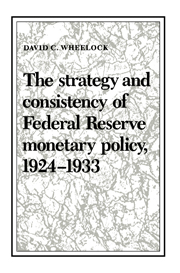Book contents
- Frontmatter
- Contents
- List of Figures
- List of Tables
- Preface
- 1 Introduction
- 2 The objectives of monetary policy, 1924–1933
- 3 Member-bank borrowing and the Fed's policy strategy
- 4 Policy disagreements within the Federal Reserve System: the effects of institutional change
- 5 Conclusion
- Appendix: Variable definitions and data sources
- References
- Index
2 - The objectives of monetary policy, 1924–1933
Published online by Cambridge University Press: 11 September 2009
- Frontmatter
- Contents
- List of Figures
- List of Tables
- Preface
- 1 Introduction
- 2 The objectives of monetary policy, 1924–1933
- 3 Member-bank borrowing and the Fed's policy strategy
- 4 Policy disagreements within the Federal Reserve System: the effects of institutional change
- 5 Conclusion
- Appendix: Variable definitions and data sources
- References
- Index
Summary
On the monetary side, the most notable feature [of the 1920s] was the close connection in timing between the movements in economic activity and the explicit policy measures taken by the Federal Reserve System.
Friedman and Schwartz (1963, p. 296)Friedman and Schwartz (1963, ch. 6) refer to the period 1921 to 1929 as the “High Tide of the Reserve System”. Under Benjamin Strong's leadership the Fed pursued an apparently successful policy of limiting fluctuations in economic activity, which, they argue, if continued would have prevented a minor recession from becoming the Great Depression.
In contrast, Wicker (1965; 1966a) contends that the apparent responsiveness of the Fed to economic fluctuations during the 1920s was unintentional. He argues that Fed officials were concerned primarily with international goals, and that domestic economic stability was at most a secondary objective. This view differs sharply from that of Friedman and Schwartz (1963, p. 269), who write that “the System frequently cited foreign considerations as a justification for the general credit policies pursued. We are inclined, however … [to conclude] that foreign considerations were seldom important in determining the policies followed.”
Chandler (1958, p. 199) argues that both domestic and international goals were important:
By 1924 Federal Reserve officials had developed three major objectives or considerations that were to shape their policies for about a decade. These were: 1) promotion of high and stable levels of business activity and employment and stability of price levels, 2) curbing excessive use of credit for stock market speculation, and 3) assistance to monetary reconstruction and stability abroad.
- Type
- Chapter
- Information
- Publisher: Cambridge University PressPrint publication year: 1991



